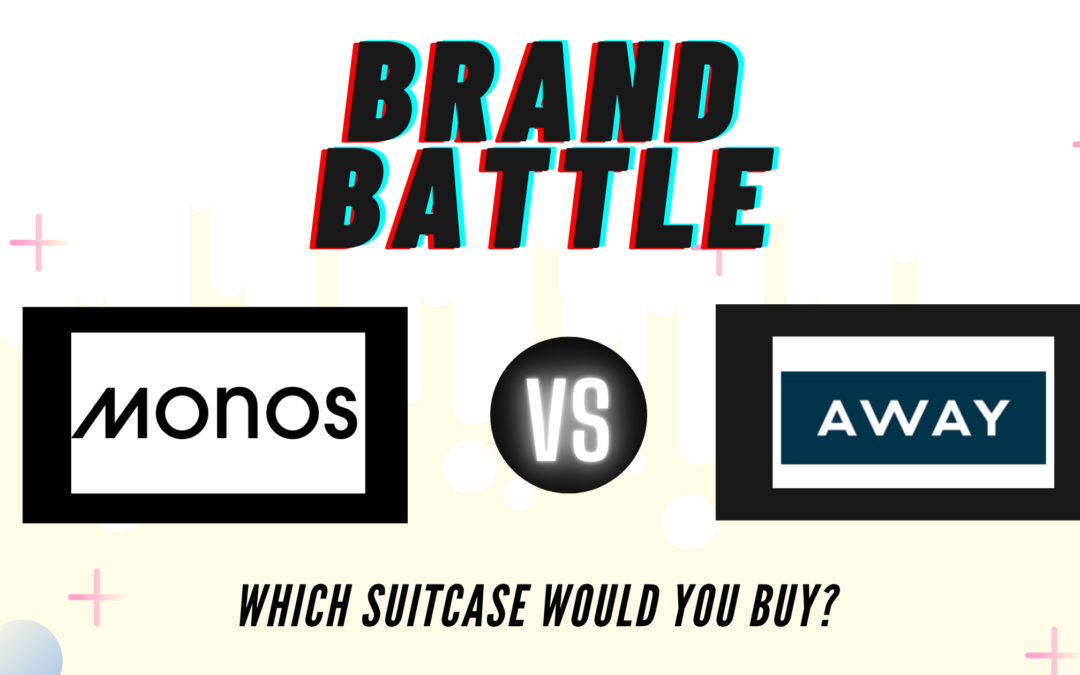What do you do when your competition has decided to sell a nearly identical product?
How do you differentiate yourself if that happens?
This seems to be the situation with luxury travel company AWAY, and their competitor Monos.
In the coronavirus lockdown, I embraced wanderlust for a minute and decided to shop for suitcases, just for fun.
What follows is my experience and thoughts buying a new suitcase. How I find, decide, and (pretend) purchase a suitcase.
You will learn:
- How to reduce wasted ad spend
- How to drive messaging that people remember
- Why branding is so important in marketing.
The Contenders
This is a classic David vs. Goliath match up.
First, there’s the obvious choice: AWAY. The pioneer Direct-To-Consumer luggage brand valued at $1.4B and has raised over $181M.
Then the lean upstart, Monos. A Canadian company launched in 2018, bootstrapped with presales and no venture capital (that I could find).
The Monos mission: “high quality, fashion-forward minimalistic design at an honest price point.” However, in my opinion mission statement could fit just as well with AWAY.
About Me, The Shopper
I’m a practical guy. I only have a few simple things that I want in my suitcase:
- Something Carry On size…
- That is durable….
- And has wheels.
In my mind, luggage is a commodity. A few times a year, I grab some clothes, stuff it in my suitcase, and head to the airport.
I don’t need any fancy brand, or my initials printed on any where.
I’m about practicality.
I’ll spend up to $300. A splurge for me!
PAID SEARCH ADS
Let’s start our search on Google.
I intentionally use a specific query: “carry on luggage purchase online”
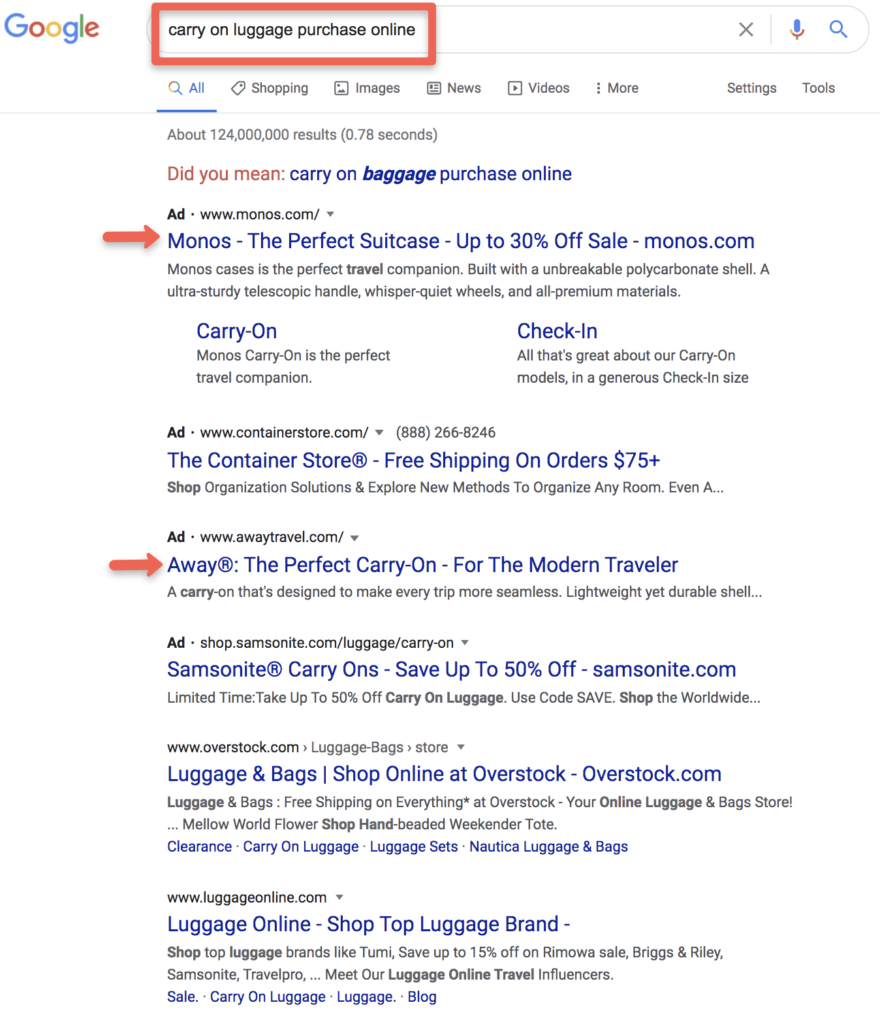
This indicates two things:
- My needs: I want to carry this on the plane.
- My intent: I want to purchase this now. Online.
This is a high intent search query. I want to find, and purchase, a suitcase.
Take a look at the two ads:


A few quick takes on the copywriting:
- Monos –
- Discount – including the sale is eye-catching, and probably drives up CTR.
- Site links – logically show the two sizes of suitcases, Carry-On and Check-In.
- Away –
- Good targeting – the Headline and Description both include my search term, “Carry-On”. This is good because it is highly relevant (this is an obvious statement, until you realize that Monos does not include the search term in the ad.
- Benefit and Features – Aspirational term for who Away is ideal for (“modern traveler”), and clear outline of features and benefits (“lightweight and durable shell”)
I click on the top two relevant ads, Monos and Away. (BTW, somebody notify that the Container Store is wasting money on any clicks here…)
Monos takes me to their homepage, which is not ideal:
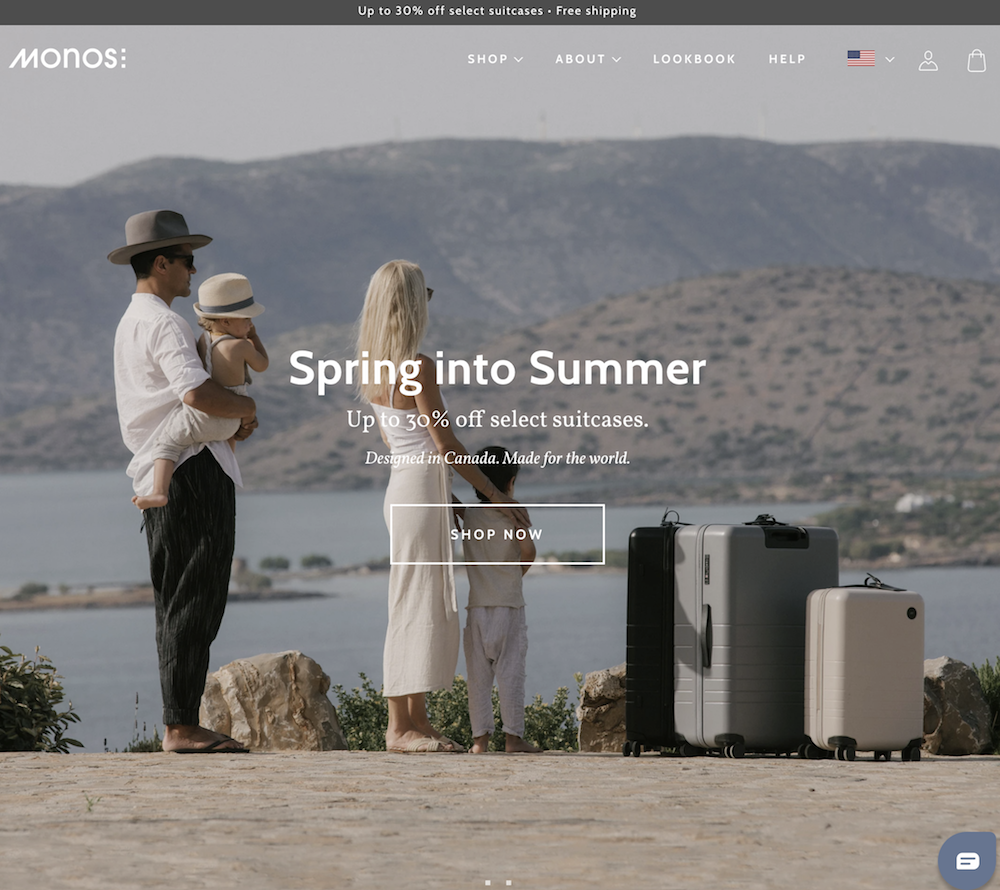
I now have to search for the product I wanted. My search query was very specific, so the ad should have directed me to the exact product that I am searching for: a Carry-On suit case.
Away takes me right to the Carry On Luggage Product Page. A much easier user experience!
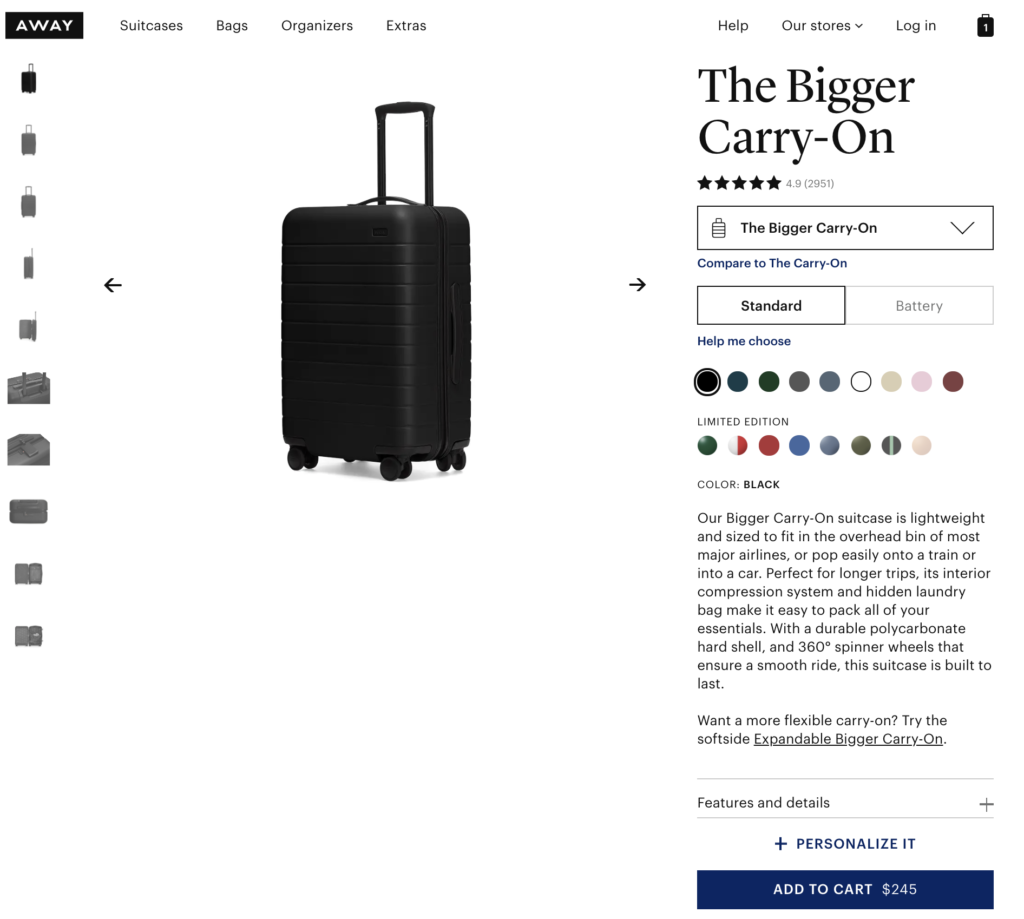
Takeaways:
- Tightly couple your ad copy to the search term — If I am searching for “carry on luggage”, include that in the headline, description, and send me to a relevant landing page. This will ultimately save money (as a result of higher Quality Score) and lead to a better customer experience.
- Use symbols to attract attention — like Away’s Registered mark. This conveys credibility and trust, which users prefer if they’re going to click your ad.
The Product Page
These are the two product pages, side by side:
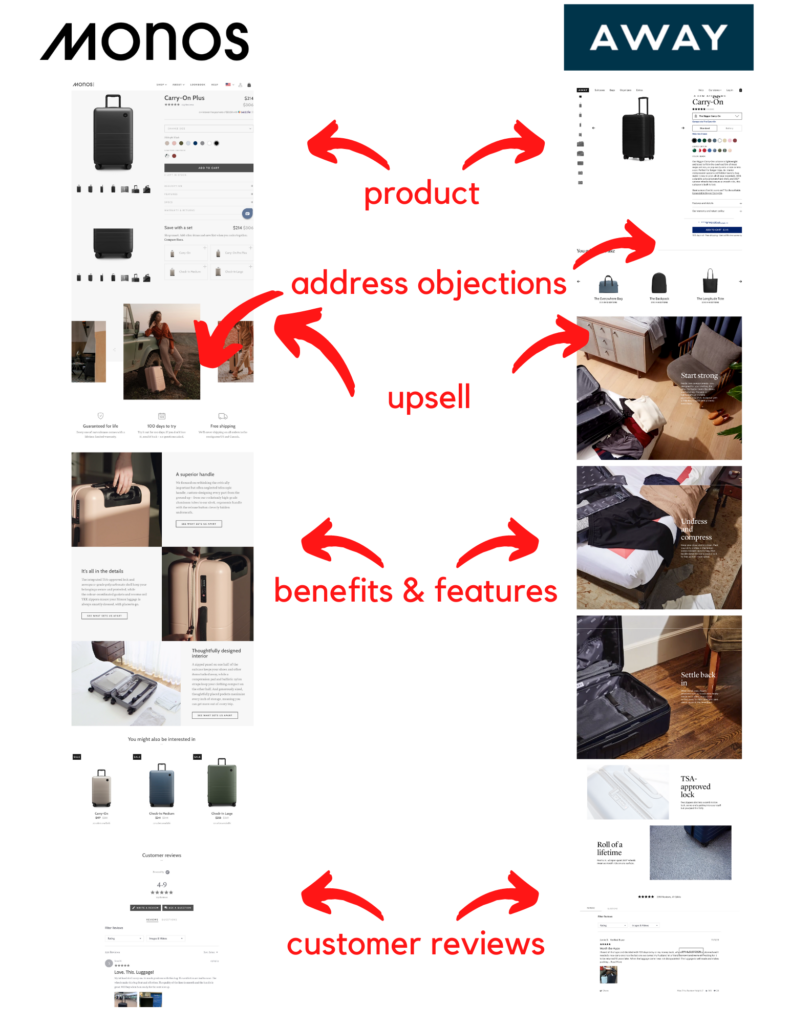
Squint just a little bit and it is hard to differentiate the two pages. The product, design, aesthetic and layout is very similar:
- Product, and product images
- Filters (size, color, preference)
- Cross sells, “you might also like…”
- The product features
- Customer reviews
Any standard ecommerce product page would have a similar layout, but it becomes challenging when your direct competition is nearly indistinguishable.
From a consumer’s perspective, it is also hard to choose between the two products….
I can’t touch the suitcases to feel the difference. I can’t speak with a sales rep to learn more about the product. The emotional connection to the brand is fully subjective based on what I choose to believe.
These two companies offer nearly identical products, and messaged in a very similar way.
As Peep Laja from CXL notes, “Differentiation is about standing out from the noise and giving people a reason to choose you over others. You’d think companies would be all about that. Curiously, not so much. In fact, it’s the opposite—the world has a massive sameness problem. Sameness is the default for most companies today.”
Between the two products, is there one that is far and away more desirable? If you’re like me, they are pretty much the same thing…
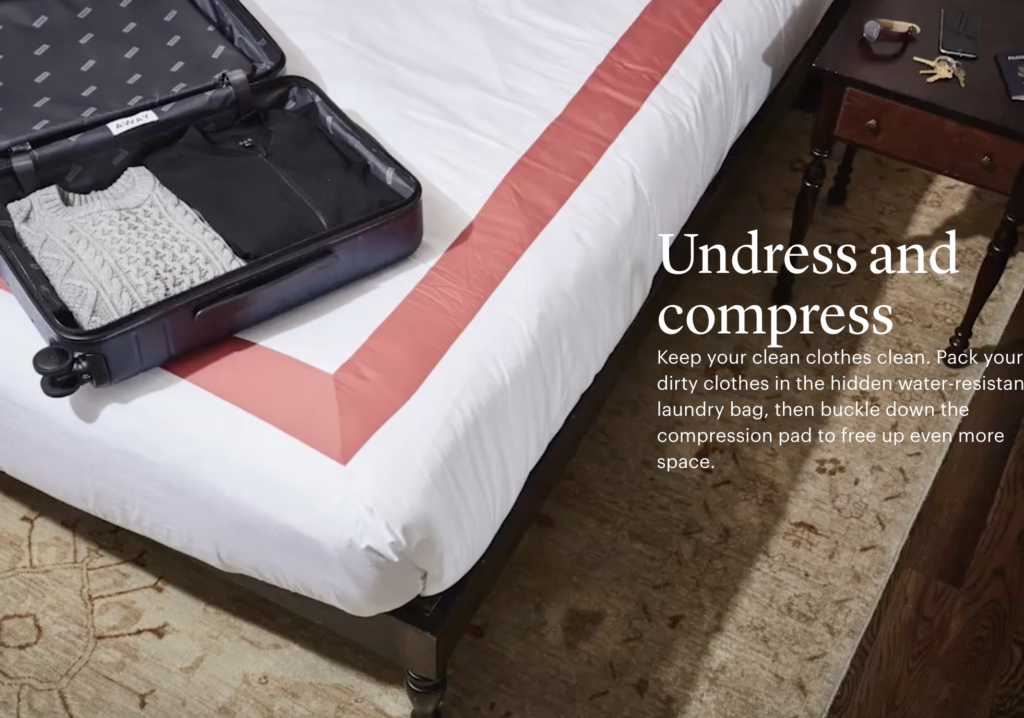
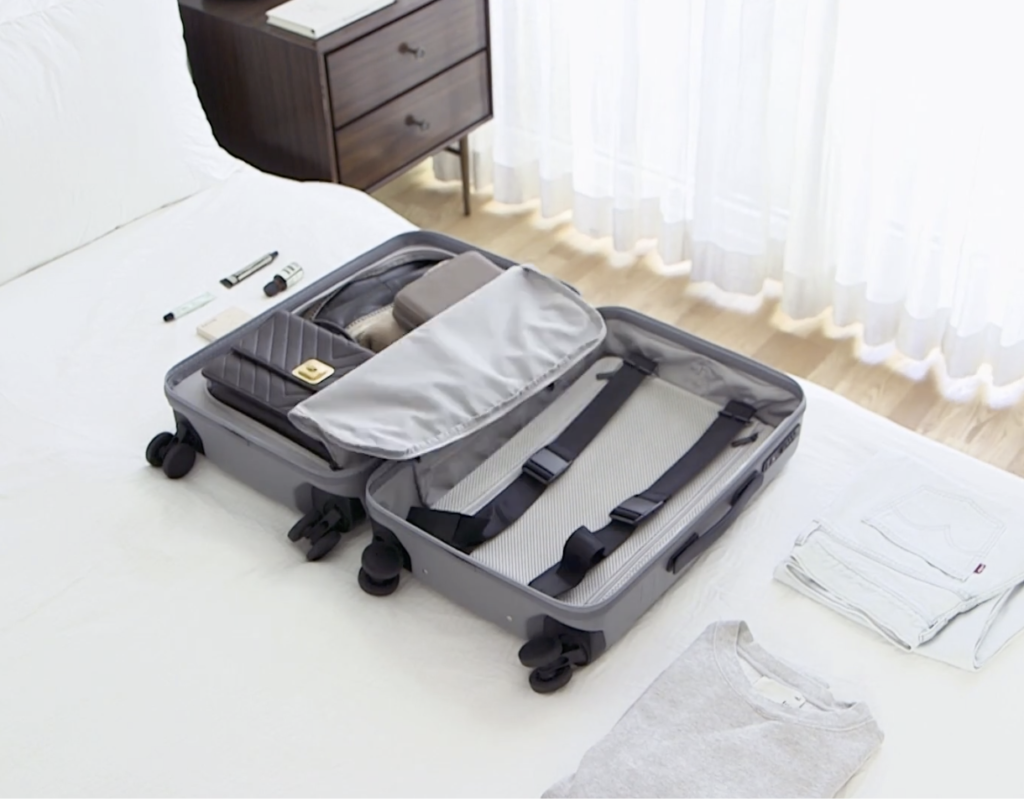
Sell On Emotion
Humans buy on emotion, justify with logic.
Remember, we’re buying a suitcase.
I see this as a commodity. So I at least want to buy the one that makes me feel something: excitement, anticipation, status.
Ultimately, all consumers make purchase decisions based on feeling and instinct.
A Nielsen study on consumer behavior confirms that emotions are the basis for our relationship with brands, and ultimately our purchase decisions.
Marketing that evokes emotion sell more.
In the study, ads that elicit emotions are associated with a 23% increase in sales over what an average ad. Ads that have a below-average emotional response are associated with 16% drops in sales volume.
Monos does a slightly better job at eliciting emotion.
This is for one reason: the images include people!
I am not just buying the suitcase, but instead i want the travel, adventure, and thrill that the suitcase represent.
As Harvard professor Theordore Levitt famously said: “People don’t want to buy a drill. They want a hole!”
I don’t want a suitcase. I want the adventure and travels that the suitcase represents (yes, we all want that during quarantine!).
Showing people and their Monos suitcase in exotic locations creates an aspirational image. It stirs up emotion–making me feel and think, “I want that!”

These product photos are important for another reason: people remember images.
When consumers hear information, they retain 10% of that information three days later. However, when the same information is accompanied by a relevant image, retention jumps to 65% of the information three days later.
The Takeaway: use aspirational images to make shoppers feel an emotion. This drives more sales, better recall of marketing, and ultimately a stronger connection to the brand.
Transparency
One strategy that Monos uses to differentiate its brand is using transparency.
On the product page, there are three different CTA buttons to “See What Sets Us Apart”, taking shoppers to a page showing the process of how the suitcases are made.
We see the raw materials, the machines, the rigorous testing:
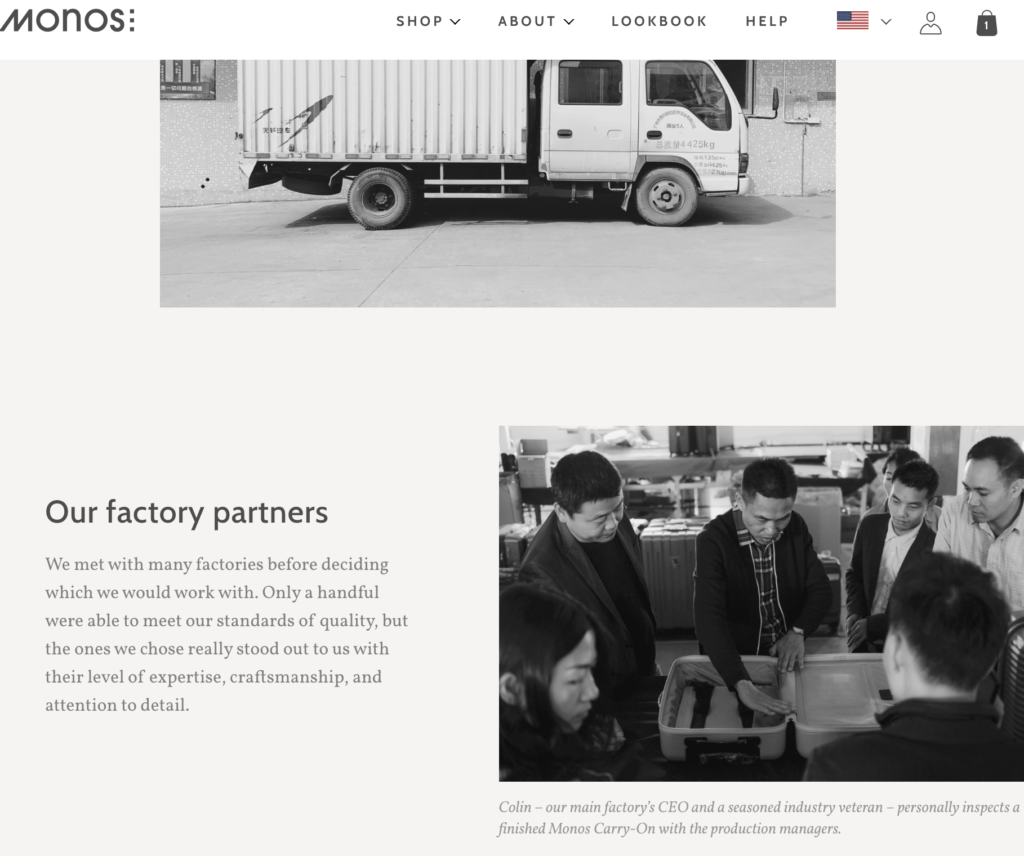
This transparency creates trust with me as a consumer. They must truly believe in the quality of the product if they can show the behind-the-scenes factory that is often obscured by consumer brands!
This is a smart strategy. The unique transparency drives me to learn more about their process, and thus get more invested in the brand. This creates a differentiated brand in my mind.
Competing In The Sea of Sameness
The Away and Monos brand go toe-to-toe in many respects. Here are some examples:
Social Proof
Not surprisingly, both brands include many 5 star reviews and photos from actual customers. Although Away has many more reviews, Monos has enough to validate that there are hundreds of happy customers.
In reality, how many reviews am I going to comb through? No more than a few.
Addressing Objections
Both Away and Monos offer 100 Days trial, Free Shipping, lifetime limited warranty.
My objections of shipping fees or guaranteed satisfaction are addressed with the exact same offers. The sameness is getting eerily similar…..
Functionality
One important feature that is easy to compare is size. I want as big of a suitcase as possible, that is still a Carry On.
Spoiler alert: both suitcases are the exact same size.
48L.
Price
Finally, a noticeably difference between the two brands: price!
Monos, on sale at $214 (reduced from $306).
AWAY is $245.
Warren Buffett famously noted, “Price is what you pay and value is what you get.”
Reviewing my mental checklist of each brand’s features, there is little difference in “what I get” from each brand.
Thus, the decision comes down to price.
I don’t have an allegiance or emotional connection to either brand, so I decide to buy based on logic…..and this means which ever one is cheaper.
My decision: Monos.
My rationale: it’s cheaper. If it was not on sale, I would buy the AWAY product.
The Takeaway
Both Away and Monos look like excellent products, with good marketing and successful businesses.
However, my purchase decision was based on price, and this is not a defensible or sustainable strategy.
I was not able to justify paying more money for an Away suitcase, if I could get a comparable product elsewhere.
This is a microcosm of the ecommerce world at large: competition is increasing, products are improving, commoditization is happening. It is harder to create a product differentiated from the competition.
AWAY was founded in 2015 as the first a modern travel and lifestyle brand.
Three years later, Monos was founded, and in just a few years has created a nearly identical product.
However, what Monos can not replicate is the brand of Away. The emotional connection that drives an initial purchase, repeat purchases, and social sharing.
The WHY that people will choose Away over Monos (or vice versa), when every other detail of the suitcase is the exact same.
This is the value of a brand–where consumers are happy to pay more money just to buy your product, because of the relationship that you have developed over time.
Don’t fall into the sea of sameness.
Create a personalized experience for your customers, discover exactly what your customers want with a quiz.
Sign up to get early access!

